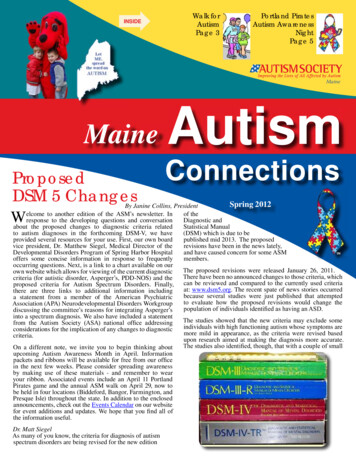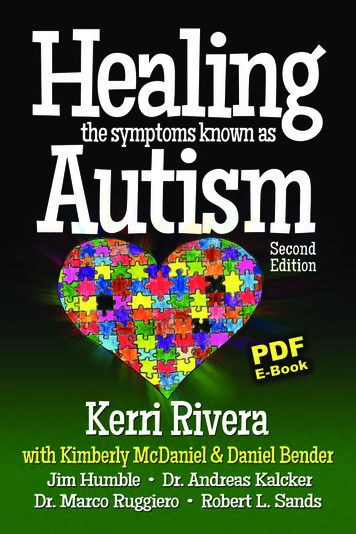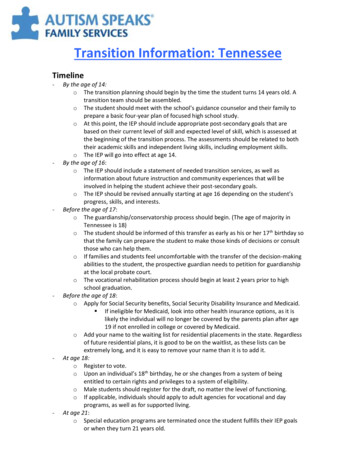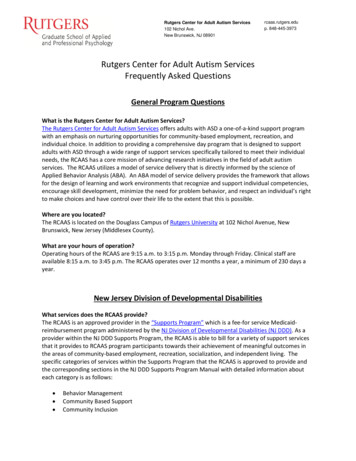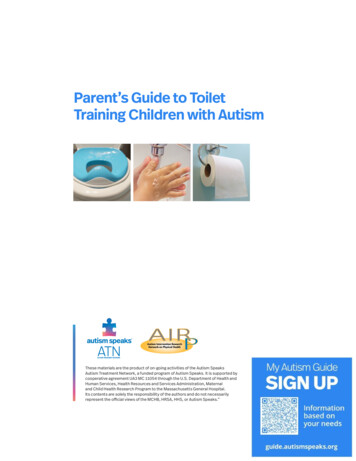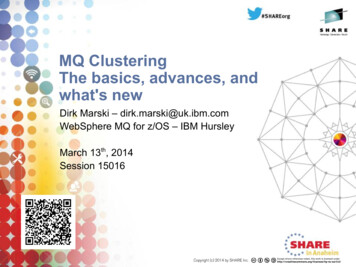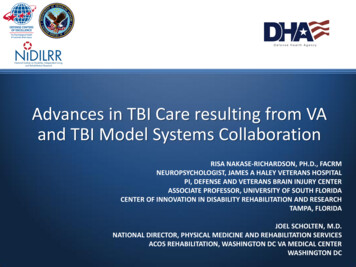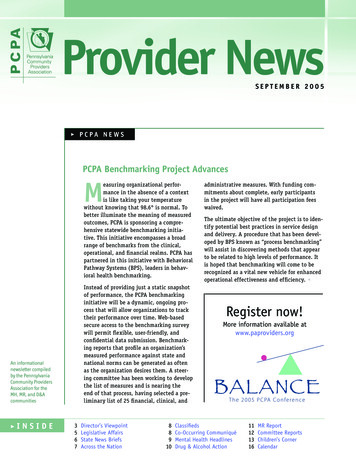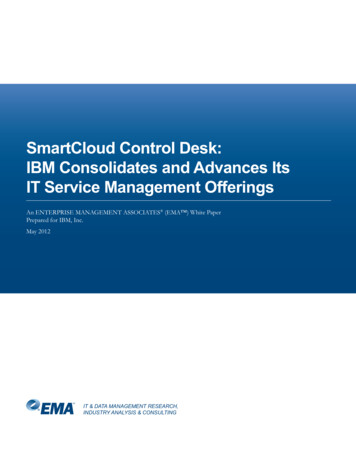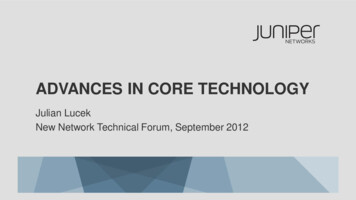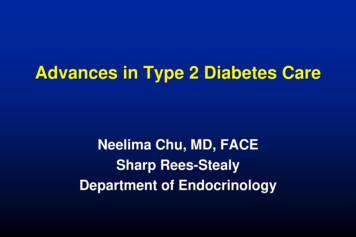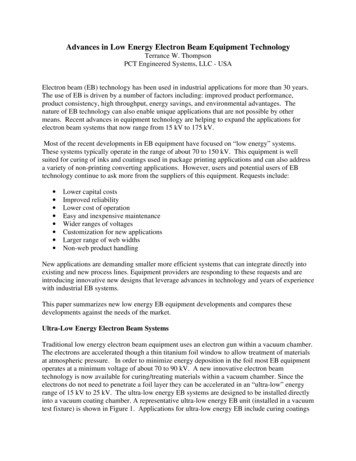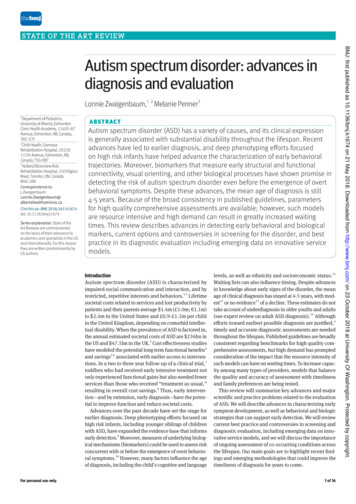
Transcription
STAT E O F T H E A RT R E V I E WLonnie Zwaigenbaum,1 2 Melanie Penner31Department of Pediatrics,University of Alberta, EdmontonClinic Health Academy, 11405-87Avenue, Edmonton, AB, Canada,T6G 1C92Child Health, GlenroseRehabilitation Hospital, 10230111th Avenue, Edmonton, AB,Canada, T5G 0B73Holland Bloorview KidsRehabilitation Hospital, 150 KilgourRoad, Toronto, ON, Canada,M4G 1R8Correspondence to:L s.caCite this as: BMJ 2018;361:k1674doi: 10.1136/bmj.k1674Series explanation: State of theArt Reviews are commissionedon the basis of their relevance toacademics and specialists in the USand internationally. For this reasonthey are written predominantly byUS authorsA B S T RAC TAutism spectrum disorder (ASD) has a variety of causes, and its clinical expressionis generally associated with substantial disability throughout the lifespan. Recentadvances have led to earlier diagnosis, and deep phenotyping efforts focusedon high risk infants have helped advance the characterization of early behavioraltrajectories. Moreover, biomarkers that measure early structural and functionalconnectivity, visual orienting, and other biological processes have shown promise indetecting the risk of autism spectrum disorder even before the emergence of overtbehavioral symptoms. Despite these advances, the mean age of diagnosis is still4-5 years. Because of the broad consistency in published guidelines, parametersfor high quality comprehensive assessments are available; however, such modelsare resource intensive and high demand can result in greatly increased waitingtimes. This review describes advances in detecting early behavioral and biologicalmarkers, current options and controversies in screening for the disorder, and bestpractice in its diagnostic evaluation including emerging data on innovative servicemodels.IntroductionAutism spectrum disorder (ASD) is characterized byimpaired social communication and interaction, and byrestricted, repetitive interests and behaviors.1 2 Lifetimesocietal costs related to services and lost productivity bypatients and their parents average 1.4m ( 1.0m; 1.1m)to 2.4m in the United States and 0.9- 1.5m per childin the United Kingdom, depending on comorbid intellectual disability. When the prevalence of ASD is factored in,the annual estimated societal costs of ASD are 236bn inthe US and 47.5bn in the UK.3 Cost effectiveness studieshave modeled the potential long term functional benefits4and savings5 6 associated with earlier access to interventions. In a two to three year follow-up of a clinical trial,7toddlers who had received early intensive treatment notonly experienced functional gains but also needed fewerservices than those who received “treatment as usual,”resulting in overall cost savings.8 Thus, early intervention—and by extension, early diagnosis—have the potential to improve function and reduce societal costs.Advances over the past decade have set the stage forearlier diagnosis. Deep phenotyping efforts focused onhigh risk infants, including younger siblings of childrenwith ASD, have expanded the evidence base that informsearly detection.9 Moreover, measures of underlying biological mechanisms (biomarkers) could be used to assess riskconcurrent with or before the emergence of overt behavioral symptoms.10 However, many factors influence the ageof diagnosis, including the child’s cognitive and languageFor personal use onlylevels, as well as ethnicity and socioeconomic status.11Waiting lists can also influence timing. Despite advancesin knowledge about early signs of the disorder, the meanage of clinical diagnosis has stayed at 4-5 years, with modest11 or no evidence12 of a decline. These estimates do nottake account of underdiagnosis in older youths and adults(see expert review on adult ASD diagnosis).13 Althoughefforts toward earliest possible diagnosis are justified,4timely and accurate diagnostic assessments are neededthroughout the lifespan. Published guidelines are broadlyconsistent regarding benchmarks for high quality comprehensive assessments, but high demand has promptedconsideration of the impact that the resource intensity ofsuch models can have on waiting times. To increase capacity among many types of providers, models that balancethe quality and accuracy of assessment with timelinessand family preferences are being tested.This review will summarize key advances and majorscientific and practice problems related to the evaluationof ASD. We will describe advances in characterizing earlysymptom development, as well as behavioral and biologicstrategies that can support early detection. We will reviewcurrent best practice and controversies in screening anddiagnostic evaluation, including emerging data on innovative service models, and we will discuss the importanceof ongoing assessment of co-occurring conditions acrossthe lifespan. Our main goals are to highlight recent findings and emerging methodologies that could improve thetimeliness of diagnosis for years to come.1 of 16BMJ: first published as 10.1136/bmj.k1674 on 21 May 2018. Downloaded from http://www.bmj.com/ on 23 October 2019 at University Of Washington. Protected by copyright.Autism spectrum disorder: advances indiagnosis and evaluation
STAT E O F T H E A RT R E V I E WSources and selection criteriaTo maximize sensitivity, we searched health, psychology,and education citation databases (including Medline,EMBASE, PsychINFO, CINAHL, and ERIC). Search termsincluded autism spectrum disorder (including Asperger’ssyndrome, autism, autistic children, autistic psychopathy,early infantile autism, and pervasive developmental disorders). For sections on early identification of the disorder,we combined these terms with “early detection” or “earlydiagnosis” or “mass screening” or “screen [tw]” using theage filter “infant, birth-23 months.” Our search was limited to English language papers only. For the diagnosissection, autism spectrum disorder terms were combinedwith diagnosis terms including medical diagnosis, delayeddiagnosis, early diagnosis, differential diagnosis, and psychiatric diagnosis. The systematic review extended from2000, when the Diagnostic and Statistical Manual of Mental Disorders, fourth edition, Text Revision (DSM-IV-TR)16was published, to 31 March 2017, when the search wasconducted. We also searched bibliographies of identifiedarticles for other relevant citations and included articlesthat were published after the search date to ensure thatour review reflects the latest information.17‑21This review could not capture all of the complexitiesof the assessment of ASD. We focused on early identification, elements of diagnostic assessment across childhood, family preferences, and ongoing assessment.Exhaustive reviews of ASD screening tools17‑19 and diagnostic tools20 21 have been published and for this reasonwere not repeated. Some important topics related to theassessment of ASD are not covered in this review, including interventions and assessment of adults.Early behavioral symptoms in ASDFrom the earliest case descriptions by Kanner,22 parents’recollections of their initial concerns have informed thesearch for early behavioral markers. The most commonlyreported initial concerns include delayed language skills,atypical social emotional responses (such as orientingto name), repetitive interests and behaviors, difficultieswith biological functions (such as feeding and sleeping),and extremes of behavioral reactivity.23‑25 An extensiveliterature based on coding of home videos also indicateddifferences in social behavior and repetitive and sensoryoriented behaviors between affected children and typically developing children that was detectable by age 12months.26‑29The shift to prospective studies of high risk infants hasenabled early features to be further delineated. EvaluaFor personal use onlyGLOSSARY3di Developmental, Dimensional and DiagnosticInterviewADHD: attention-deficit/hyperactivity disorderADOS: Autism Diagnostic Observation ScheduleADI-R: Autism Diagnostic Interview-RevisedAOSI Autism Observation Scale for InfantsCARS: Childhood Autism Rating ScaleCARS-2: Childhood Autism Rating Scale, 2nd editionCSBS DP: Communication and Symbolic Behavior ScalesDevelopmental ProfileDSM-IV/V: Diagnostic and Statistical Manual of MentalDisorders, fourth/fifth editionDSM-IV: Diagnostic and Statistical Manual of MentalDisorders, fourth edition, Text RevisionEEG: electroencephalographyERP: event related potentialESAT: Early Screening of Autistic TraitsIBIS: Infant Brain Imaging StudyICF: International Classification of Functioning, Disabilityand HealthITC: Infant/Toddler ChecklistMRI: magnetic resonance imagingM-CHAT: Modified Checklist for Autism in ToddlersM-CHAT-R/F: M-CHAT Revised with Follow-UpRCT: randomized controlled trialSCQ: Social Communication QuestionnaireSORF: Systematic Observation of Red FlagsSRS, SRS-2: Social Responsiveness ScaleUSPSTF: US Preventative Services Task Forcetions in the first year suggest the emergence of an ASDprodrome,30 which includes reduced motor control,31‑34attention, and emotional regulation before the development of overt social communication impairments andrepetitive behaviors.19 In the second year, reduced orienting to name34‑37 and deficits in joint attention behaviors (both responding38 39 and initiating40‑42), as well asreduced shared positive affect,29‑37 are among the mostconsistently identified features. Several independent longitudinal studies have implicated atypical developmentaltrajectories, with progressive reduction in age appropriate social behaviors,43 as well as evidence of “plateauing” of language and non-verbal cognitive skills.44 45Atypical use of objects, such as spinning, lining up, andvisual exploration, has also been consistently reported tostart at 1 year.37‑49 Several groups have investigated parent reported temperament in high risk infants, both asa theoretical framework for relevant domains50 as wellas a potential early detection strategy. Reduced effortfulcontrol (self regulation) and surgency (positive effect andsocial approach), and increased negative affect have beenassociated with ASD among high risk infants, as reportedin older children with the disorder.50‑53 With the exception of a few studies, which have examined individualsymptoms such as repetitive behaviors48 and responseto name,36 and a preliminary analysis of a more comprehensive scale,34 most behavioral studies in high riskinfants have focused on group comparisons rather thanindividual level classification.2 of 16BMJ: first published as 10.1136/bmj.k1674 on 21 May 2018. Downloaded from http://www.bmj.com/ on 23 October 2019 at University Of Washington. Protected by copyright.PrevalenceASD is one of the most common childhood onset neurodevelopmental disorders. Recent prevalence estimates arebetween 1% and 1.5%, with relative consistency acrossstudies internationally.14 15 The interpretation of apparentincreases over the past 20 years remains controversial15(the relative contributions of a genuine increase versusgreater awareness or improved ascertainment), but thecurrent prevalence warrants consideration of assessmentmodels that use community capacity rather than relyingentirely on tertiary level centers.
STAT E O F T H E A RT R E V I E WCross sectional studies of potential biomarkersUntil recently, most published studies compared biomarkers of typically developing controls or referencenorms with those of older children or adults with thedisorder. This is also true for recent studies examiningmetabolomics,61 62 markers of inflammation63 and oxidative stress,64 and salivary proteomics.65 Such findingscannot be readily generalized to early detection becausebiomarkers generally reflect dynamic processes thatchange over the course of development. Cross sectionalstudies of blood based biomarkers in newborn and infantsamples may be more informative—for example, in onecase-control study mRNA expression profiles in community identified toddlers with ASD differed from those oftypically developing controls, with optimal sensitivityand specificity of 73% and 68%, respectively, in a crossvalidated sample.66 Maternal and newborn immunoglobulin levels have also been examined in relation to the riskof ASD,67 although no data on individual level predictionhave been reported.Prospective studies of potential biomarkers in high riskinfants: early brain developmentThe search for early brain based biomarkers is guidedby extensive evidence of atypical cortical activation,68brain growth trajectories,69 70 and functional and structural connectivity in children and adults with the ASD.71Electroencephalography (EEG) provides a temporally precise measure of postsynaptic brain activity at rest andin response to specific stimuli (event related potentials;ERPs) and can be useful when studying early brain functioning in ASD.72 Several prospective studies have positedEEG metrics as potential early biomarkers of ASD. Tierneyand colleagues reported that developmental trajectoriesof resting EEG power from 6 months to 12 months of agedistinguished high risk from low risk infants but was notspecifically associated with symptoms of ASD.73 Righi andcolleagues reported on linear coherence, a global indexof EEG signal synchronization, in response to auditorystimuli in a sample of 28 high risk and 26 low risk infants.Compared with the low risk group, at 12 months of agehigh risk infants displayed lower linear coherence, withFor personal use onlymarginal differences related to ASD outcome (n 5).74Elsabbagh and colleagues,75 in an extension of a previousreport,76 assessed ERPs in 40 high risk and 45 low riskinfants who viewed faces that appeared to gaze towardrather than away from them. ERP responses at 6 monthsto 12 months of age differentiated the 13 high risk infantsdiagnosed with ASD at 36 months from non-diagnosedhigh risk infants and low risk infants. Sensitivity andspecificity with respect to individual diagnostic outcomeswere not reported in these studies.A series of findings from the US Infant Brain ImagingStudy (IBIS) Network indicate that magnetic resonanceimaging (MRI) based biomarkers are remarkably accuratein predicting ASD at 6-12 months of age.77 Hyperexpansion of cortical surface area at 6 months and 12 months,which preceded brain volume overgrowth at 12 monthsand 24 months, informed a deep learning algorithm thatcorrectly classified 30 of 34 high risk infants diagnosedwith ASD at age 24 months (sensitivity 88%) and 138of 145 high risk infants not diagnosed with ASD (specificity 95%).78 Also in the IBIS high risk cohort (n 59),a functional connectivity MRI based machine learningalgorithm applied at 6 months of age had a 81% sensitivity and 100% specificity for the diagnosis of ASD.79Increased extra-axial cerebral spinal fluid volume at6 months of age correlated with motor function at 6months and was associated with a diagnosis of ASD at24 months (80% sensitivity and 67% specificity).80 ASDrelated connectivity differences mapped to functionalnetworks underlying joint attention skills at 12 monthsand 24 months.81 Such differences were associated withreduced local efficiency (reduced capacity to transmitinformation across a network) in several brain regions.Functionally relevant developmental progression withreduced efficiency in the right primary auditory cortexwas seen at 6 months, which extended to regions underlying higher order cognitive functions by 24 months.82 Highrisk infants were also differentiated by white matter tractdevelopment starting at 6 months of age, as assessed bydiffusion tensor imaging, 83 which was related to atypicalvisual orienting at 7 months84 and repetitive behavior andsensory responsiveness at 24 months.85These findings are complemented by a smaller studyof community identified 1 year to 4 year old childrenwith ASD who had atypical development of white matterultrastructure relative to typically developing controls,particularly in the frontal tracts86 and within the corpuscallosum in those younger than 30 months.87Prospective studies of potential biomarkers in high riskinfants: early visual orientingGaze metrics might be considered at the boundarybetween behavioral and biologic markers of ASD.Although visual orienting is directly observable, it mayindex a more basic neuropsychological process thanother behavioral symptoms and can be objectivelymeasured using eye tracking. A review of 122 studiesindicated atypical gaze patterns across the lifespan inpeople with ASD, consistent with fundamental deficitsin selecting and attending to information needed to perceive social interactions accurately.88 Numerous studies3 of 16BMJ: first published as 10.1136/bmj.k1674 on 21 May 2018. Downloaded from http://www.bmj.com/ on 23 October 2019 at University Of Washington. Protected by copyright.Potential for presymptomatic detection: advances inbiomarker researchAlthough behavioral features may not be fully manifest orsufficiently specific to support early detection, measuresof underlying biological processes offer an alternativemeans to identify at risk infants. Biomarkers are definedas characteristics that are objectively measured as indicators of normal biologic processes, pathogenic processes,or pharmacologic responses to therapeutic interventions.54 Biomarkers can be applied for many purposesin relation to ASD including risk assessment, diagnosis,and characterization of symptom severity.55 Longstandinginterest in potential biomarkers for the diagnosis of ASDdates back to studies on blood serotonin reported in the1970s.56 Several reviews have highlighted the potentialbenefits of earlier detection and targeted interventions bypursuing assessment measures that focus on underlyingbiology rather than downstream behavioral effects.10‑60
STAT E O F T H E A RT R E V I E WFor personal use onlyPotential clinical utility of predictive biomarkers for ASDAs summarized in table 1, some of these candidate biomarkers are associated with sensitivity and specificity estimatesthat compare favorably with those of previously reportedbehavioral signs and they have the advantage of potentiallybeing detectable earlier. Presymptomatic detection of ASDwithin a high risk family is an important advance and thepotential for broader application in the community couldtransform clinical practice. However, the generalizability offindings to non-familial low risk (and other high risk risk)samples must first be established. Moreover, screeningalgorithms derived from machine learning (thus, sampledependent) analyses need replication using hypothesesdriven designs. The feasibility of implementation in the general community must also be established, with consideration of necessary training, acceptability to parents, and costs,although potential long term savings related to improved outcomes resulting from earlier diagnosis and treatment shouldbe taken into account.8 Finally, because of the etiologic heterogeneity of the disorder some biomarkers may be specificto certain subtypes of ASD and informative for only a subsetof cases.113 Such biomarkers might be used to individualizetreatment in the future, but are less likely to be useful forearly detection and screening in the absence of clinical correlates that could be used to pre-stratify the target sample.Although there is reason for excitement at the promiseof biomarker based screening, from a public health perspective, behavioral markers such as parental concernscan be just as informative. “Pencil and paper” tasks arenot inherently inferior to technologically sophisticatedmeasurement strategies.102 All potential markers can beconsidered with respect to classification accuracy, feasibility, acceptability to parents, and cost effectiveness.Screening and surveillanceWhereas biomarkers have mainly been assessed in relatively small high risk cohorts, several behaviorally basedscreening tools have been evaluated in large communitysamples. An ex
, fourth edition, Text Revision (DSM-IV-TR) 16. was published, to 31 March 2017, when the search was conducted. We also searched bibliographies of identified articles for other relevant citations and included articles that were published after the search date to ensure that
